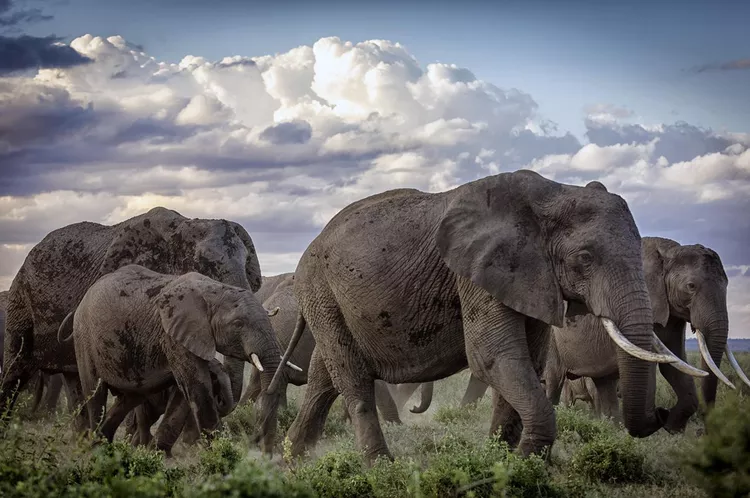Summary
Kenya
The prime time to embark on a safari in Kenya, where you can experience a rich density and diversity of wildlife, is during the annual migration of millions of wildebeest, zebra, and gnu. This breathtaking spectacle occurs from July to October. For other parks in Kenya, visit during the dry season—January through March and July through October.
During the dry season, animals tend to gather around permanent waterholes and lakes, making them easier to spot. Additionally, the less lush vegetation enhances visibility from a distance, ensuring viewers can appreciate the majestic wildlife.
Tanzania
To witness the Great Migration, Tanzania’s northern parks—particularly the Serengeti and Ngorongoro—are the ideal places to go. The best period to experience this migration is from February to March, coinciding with the birthing of wildebeest and zebra calves. This time also attracts a higher number of predators.
Moreover, from June to November, Tanzania experiences its dry season, making it the optimal time to visit various parks, including a chance to see the migration in Kenya’s Masai Mara. The Southern Parks in Tanzania are also favorable during this period because animals return to permanent water sources, making encounters more frequent and enjoyable.
Keep in mind that Tanzania’s parks face rainy seasons, particularly from March to May in the North and November to May in the South and West, which may affect road conditions and visibility.
Uganda
Uganda boasts spectacular National Parks which are best visited from December through March or June through September, primarily during dry spells. Many visitors choose Uganda to see the renowned Mountain Gorillas. It’s advisable to avoid visiting during the rainy months of March and April, or October and November, when treks can become challenging.
Zambia
The optimal time to experience Zambia’s wildlife is from September through mid-November, marking the end of the dry season. Elephants, buffalo, and other wildlife are plentiful in the Lower Zambezi Valley. Although April to September is also suitable for a safari, many parks remain less accessible after that, and road conditions can affect your experience.
Additionally, November introduces a smaller version of the Great Migration, where approximately 30,000 wildebeest gather in Liuwa Plain National Park—a unique event worth planning a trip around.
Zimbabwe
Zimbabwe’s wildlife parks, especially Hwange, shine from July to October. The conditions during this period are exceptional for game viewing, making it an excellent safari destination. Whitewater rafting on the Zambezi is best from August to December when water levels drop, leading to thrilling rapids.
Meanwhile, Victoria Falls reaches its peak flow in March and April post-rainy season, providing awe-inspiring views, although visitors might experience significant spray.
Botswana
Your safari experience in Botswana will be most memorable from June through September. During this time, the weather is generally dry and warm, encouraging large herds to congregate around the Okavango Delta. A traditional canoe ride during this period is particularly rewarding.
Botswana is regarded as one of Africa’s most luxurious safari destinations—many parks are difficult to access, frequently requiring private flights. If you aim to explore Botswana while staying within budget, consider visiting during the shoulder seasons in April, May, or October.
Namibia
For an unforgettable safari experience, visit Etosha National Park in Namibia between May and September. This dry season encourages wildlife to gather around waterholes, enhancing viewing opportunities. For bird enthusiasts, summer months from December to March also present fantastic birdwatching, though be prepared for heat and humidity.
South Africa
The prime safari areas in South Africa, particularly around Kruger National Park, are best explored between June and September when conditions are cooler and drier. South Africa is unique in that its infrastructure can accommodate rainfall; therefore, visiting during wet conditions doesn’t necessarily deter safari experiences.
When to Go
When planning a safari, timing may rely on your availability. If seeking the best wildlife viewing opportunities regardless of the destination, this month-by-month guide will significantly assist in planning your journey.
- January: A premier month for safaris in Kenya, Tanzania, and Uganda, with dry weather drawing animals to permanent water sources.
- February: An opportune time in Tanzania’s northern parks for witnessing thousands of wildebeest births, particularly appealing for wildlife enthusiasts.
- March: East Africa retains its allure, with abundant wildlife during the dry season. However, those wishing to see gorillas should avoid this month.
- April: A transitional month where rains begin in East Africa, and safari discounts may be found. Southern Africa welcomes drier weather through April.
- May: Zambia emerges as a favorable safari destination as the dry season sets in, while other Southern Africa countries experience improving conditions.
- June: This month marks the transition into the high season for Southern African safaris. Expect cooler evenings and early mornings during game drives.
- July to September: All major safari destinations thrive, showcasing the Great Migration in Kenya and excellent viewing experiences in Southern Africa.
- October: Zimbabwe, Kenya, and Tanzania remain prime safari spots as dry weather continues enhancing wildlife viewing prospects.
- November: Zambia experiences its unique wildlife events, while Northern Tanzania offers rewarding migration-viewing opportunities.
- December: East Africa dominates again as a favored safari choice, perfect for a festive retreat among wildlife.
Best Times to See Specific Animals
- Gorillas: These majestic creatures attract visitors year-round, but tracking is challenging in the rainy seasons (March-April and October-November).
- Chimpanzees: Safaris can be enjoyed year-round, although the dry season (July-October and December) provides enhanced walking and photography opportunities.
- Whales: The prime season for whale watching in South Africa occurs between June and November when the coastline becomes a sanctuary for numerous species.
- Birds: Optimal birdwatching in Southern Africa is between November and March, while East Africa offers fantastic experiences in January through March.




